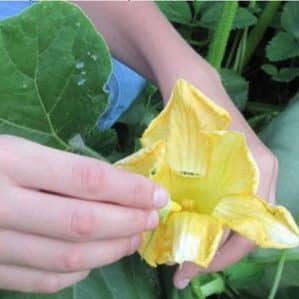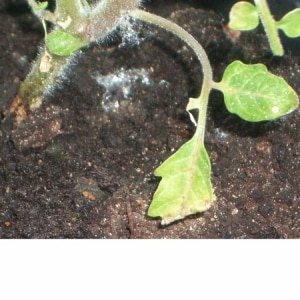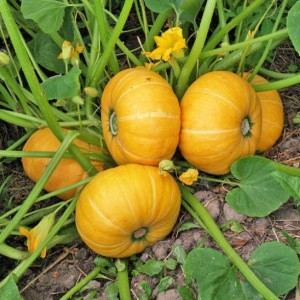Instead of ovaries on a pumpkin, there is a barren flower - what to do and how to deal with it: we identify the causes of the problem and solve them
Pumpkin is a favorite of many summer residents: its fruits grow large, have high nutritional value, and at the same time look bright and impressive. But not every gardener manages to grow a decent harvest. Often, thick and fleshy vines are strewn with barren flowers, and the desired ovaries are never formed.
In the article we will consider the causes of this scourge, what are the methods to combat it and preventive measures.
Why pumpkin doesn’t set fruit: how to fix it and what to do
The most common reasons for the absence of ovaries:
- adverse weather conditions;
- errors in agricultural technology (incorrect feeding, ignoring pinching);
- illnesses and pests.
Poor pollination
Like other monoecious plants, the same pumpkin bush contains both male and female flowers. The ovaries are formed on the female ones, but without pollen transferred from the male flowers, the birth of the fruit does not occur. Due to the structural features of the flower (the genital organs are located deep), pollination is impossible without the participation of insects - bees, bumblebees, wasps.
The following factors can scare off pollinating insects:
- too cold or, conversely, hot weather (below +12°C and above +35°C);
- heavy rainfall;
- strong wind;
- use of strong insecticides to control pests;
- lack of honey-bearing herbs and flowers on the site.
One of the easiest ways to attract bees is to spray flowers with sweet syrup.
Excess fertilizer
Excess nitrogen in the soil lengthens the growing season, that is, it leads to later flowering and ripening of fruits against the background of excessive growth of green mass.
For pumpkin, organic fertilizers applied to the soil in advance - in the fall - are sufficient. Additional fertilizing is carried out when the earth warms up to +12-13°C and during the period of active flowering.
Reference. A sign of too much nitrogen is dark green leaves and a plant stem that is too thick.
Dense foliage
Inexperienced summer residents rejoice and are proud of the rich foliage on the pumpkin shoots. But it is worth remembering that resources - water and nutrients - are limited in the ground and if too much of them enters the foliage, flowers and fruits will have to be content with meager remains.
Reference. The main stem of long-climbing varieties can reach 15 m in length, and the total foliage area is 30 m².
Excessively long stems also do not promise a rich harvest. Their timely pinching will help preserve the plant’s strength to form ovaries. After this, the side shoots begin to grow stronger, on which female flowers are formed.
Root rotting
Pumpkin has a powerful root system that provides the plant with moisture and nutrients dissolved in it. If something interferes with the development of roots, the above-ground part of the vegetable will inevitably suffer - fruits will not form.
A fungal disease - root rot - depletes the plant and leads to its death. Characteristic signs of infection are a brownish-gray color at the base of the stem and yellowed lower leaves, cracked and softened roots.
The appearance of rot is provoked by:
- large range of day and night temperatures;
- insufficient lighting;
- watering with cold water;
- irregular weeding.
Another cause of root damage is mechanical trauma during thinning of seedlings. To avoid this, it is recommended to prune weak shoots rather than pull them out.
Weak sprouts
Insufficiently strong seedlings are not capable of producing a good harvest. Most often, weak shoots are observed if:
- the seeds were planted in cold soil;
- the landing site is shaded;
- Sufficient food is not provided.
Pumpkin is a light-loving and heat-loving crop. If climatic conditions are unfavorable for it, use film or other covering material at the stage of active plant growth. The viability of seedlings will be ensured by fertilizing with ash and a combination of nitrophosphate with mullein.
Advice. When choosing varieties for different climatic zones, it should be taken into account that the most heat-loving is the nutmeg pumpkin, and the most resistant to cold is the hard-bark pumpkin.
The ovaries are rotting
Sudden frosts or prolonged rains lead to the death of the ovary. The only salvation is timely organization of shelter, loosening, mulching, and construction of raised beds.
Rotting of the embryos is a natural protective reaction of the pumpkin to the lack of pollination. To prevent the unformed ovary and faded flower from attracting infection and pests, the plant strives to get rid of them.
Attention! The number of ovaries depends on the variety. For example, female flowers in climbing varieties make up about 10% of the total, and in bush varieties - 40–50%.
Plant pests and diseases
Pumpkin can hardly be called a pampered vegetable, but diseases and pests are not alien to this crop.
Under unfavorable conditions (lack of lighting, waterlogged soil, cold temperatures) and in case of infection of the soil or seed material, the plant is susceptible to bacterial and fungal diseases:
- bacteriosis;

- white rot;
- root rot;
- powdery mildew.
Insects are also dangerous for pumpkins:
- spider mite;
- melon aphid;
- meadow moth.
To combat these problems, fungicides and pesticides are used:
- “Topaz” - against white rot;
- “Quadris”, “Tiovit jet” - against powdery mildew;
- "Fundazol" - against root rot;
- "Fentiuram" - against bacteriosis;
- "Aktellik" - from melon aphids;
- "Karbofos" - against spider mites;
- "Fufanon" - from the meadow moth.
Prevention includes:
- feeding with mineral complex fertilizers to increase immunity (zinc sulfate, potassium permanganate, copper sulfate, boric acid with urea);
- regular inspection and removal of damaged shoots.
What to do so that the pumpkin actively forms the ovary
What to do if there is a barren flower on the pumpkin? Knowing the reasons why ovaries do not form on pumpkin bushes and vines, it is easier to deal with the problem.
To get a harvest, you should:
- artificial pollination;
- plant formation;
- care activities.
Artificial pollination of pumpkin
The artificial pollination procedure goes like this:
- Select a male flower with abundant and dry pollen and remove its petals. Related crops can be used as “donors” - zucchini and squash.
- Bring the stamen of the “male” to the pistil of the female flower. To transfer pollen carefully, use a brush: brush it over the stamen, then stroke the pistil.
- If hand pollination is successful, the ovary on the female flower will begin to increase in size.
Keep in mind that flowers of different sexes appear on the plant at different times: male flowers earlier than female ones, so it is important not to miss the moment when the latter open.
It is advisable to carry out pollination in the morning, in dry and warm weather. Both flowers should be open, without moisture inside.
Plant Formation
A necessary condition for a rich pumpkin harvest is topping lashes and bushes. This will help the plant save microelements obtained from the soil and direct them to the formation of ovaries.
Options for pinching climbing and bush varieties:
- leave one main shoot and ovary, remove the rest;
- leave the main stem and one powerful shoot with a total number of fruits of no more than four;
- leave one main and two side shoots with 3-4 fruits.
The top of the shoots is pinched off, counting 4-5 leaves from the outermost fruit on the stem.
Reference. The fewer shoots and ovaries remain on the plant, the larger the fruit will be.
Caring for pumpkin during flowering

During flowering, the pumpkin needs watering more than in other stages of its development. But you should not over-water the vegetable - this can lead to rot. It is enough to water the soil under the bush once a week, the water should be warm (within +20°C). To prevent it from stagnating, the soil should be loosened and the procedure itself should be carried out in the evening.
During the flowering period, feeding the plant is necessary. For example, a solution of 2 tbsp. l. superphosphate and 1 tbsp. l. potassium sulfate in a bucket of water.
Reference. Special preparations “Ovary” and “Gibbersib” increase productivity. These products contain phytohormones that activate the synthesis of nucleic acids and proteins, due to which flowering is accelerated and the ovary is formed even under unfavorable conditions.The preparations are intended for spraying in the initial flowering phase.
Caring for a pumpkin after pinching
To ensure the supply of more nutrients, after pinching, the lateral internodes can be rooted. To do this, they are sprinkled with fertilized soil. After some time, the shoots should form strong roots that will provide the plant with stability.
Ovary control
To prevent barren flowers from growing, control the formation ovaries. When the rudiment of a future fruit is detected, the shoot can be pinched so that nutrition is distributed efficiently.
In favorable conditions, the vine will regularly produce female flowers, but if you leave them all, the vegetables will be smaller. To grow large pumpkins, it is better to get rid of excess ovaries.
Advice from experienced summer residents
If in the garden pumpkin blossoms, but there is no ovary, use the recommendations of experienced vegetable growers:
- Growing late-ripening large-fruited pumpkins is risky, since deteriorating weather conditions in late summer reduce the number of pollinating insects. Early and mid-ripening varieties are more suitable for a beginning gardener.

- When artificial pollination is used, it is important to select male flowers from ovaries growing in a sunny, illuminated area. It is better to carry out the procedure on the same day when the flower blooms - it contains more pollen.
- Bees and bumblebees do not like flowers with water inside. Therefore, watering should be carried out with the buds closed, making sure that it is not the leaves and stems that are moistened, but the soil. The plant will absorb the necessary moisture through the roots.
- It is permissible to grow pumpkins in the same greenhouse with cucumbers. When the shoots reach 50-60 cm, they are taken out into open ground, leaving the roots in the same place.
- Pumpkin takes all minerals from the soil, so it can be planted in the same place no earlier than after 5 years.
Preventive measures
To avoid a problem when the pumpkin does not set fruit, we recommend taking preventive measures:
- To form ovaries, seeds that are 2-3 years old will be required. Material from last year's harvest produces almost no female flowers.

- Crop rotation is of great importance for proper nutrition of plantings and prevention of diseases. Pumpkin prefers virgin and fallow lands and soil after potatoes, onions, and various types of cabbage. The area itself should be well heated by the sun.
- The density of sowing affects the yield; planting 1-5 plants on an area of 10 m² is considered optimal.
- To avoid overfeeding with nitrogen, it is recommended to apply fertilizers in advance - in the fall.
- Pumpkin requires rare but abundant watering with warm water. Overmoistening will lead to the formation of rot, while lack of moisture will lead to dehydration and “dropping” of flowers and ovaries.
- In unfavorable climatic conditions, it is better to grow pumpkins in a greenhouse. When covering plants overnight in film, make cross-shaped cuts in it for better ventilation, otherwise the ovaries will rot.
Conclusion
Pumpkin looks spectacular in a summer cottage, but without pollination and compliance with the rules of agricultural technology, powerful shoots and large flowers will remain only decoration. The fruits will not ripen if the ovaries do not form or die. To avoid this, carry out pinching of vines, activities to attract bees or artificial pollination, monitor the balance of nutrients in the soil and monitor how the pumpkin blooms.
How did I find out about the pollination of pumpkins with squash and zucchini, I suddenly didn’t want to read this nonsense
In fact, these are related plants, and cross-pollination is possible. We once grew “pumpkins” and “pumpkins”. Very interesting shapes and colors...
What a waste of pollination if there is not a single ovary on a dozen bushes, there is nothing to pollinate!!! Hundreds of flowers - and ALL empty flowers!!! At the same time, the neighbors’ zucchini and pumpkins are already ripening... How so??? It's clearly not a matter of weather conditions, and 🐝 has nothing to do with it.
In fact, these are related plants, and cross-pollination is possible. We once grew “pumpkins” and “pumpkins”. Very interesting shapes and colors...